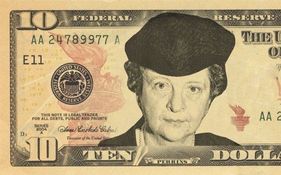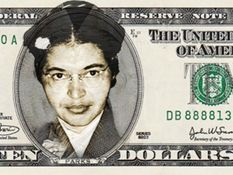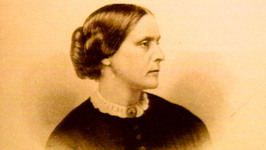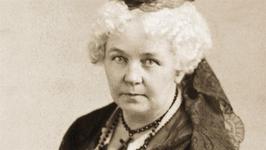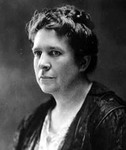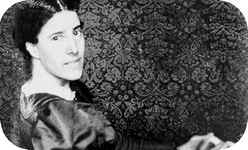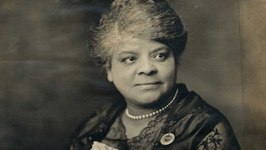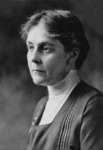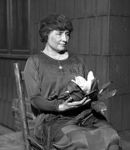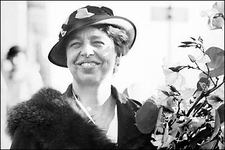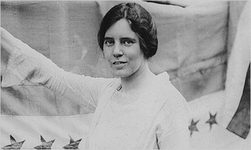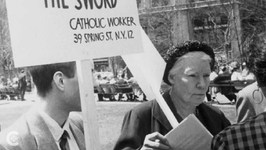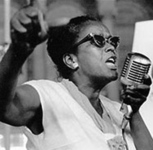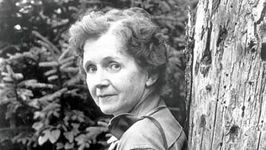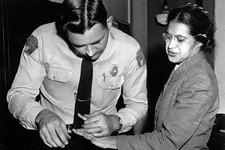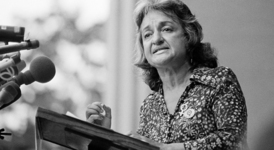In a speech last year in Kansas City, President Barack Obama said he received a letter from a nine-year-old girl that included a list of possible women to put on America's paper bills and coins, "which I thought was a pretty good idea." This March, Barbara Ortiz Howard and Susan Ades Stone started a campaign called Women on 20s to demand that the government replace former President Andrew Jackson's image on the $20 bill with a woman from history.
Now, the Obama administration is following through, although not in the way that the two women and the many followers they galvanized had hoped. Last week, Treasury Secretary Jack Lew announced that in 2020 -- the 100th anniversary of the 19th Amendment granting women the right to vote -- a woman will appear on the $10 note, not the $20 bill.
Lew explained that the $10 bill was already scheduled to be redesigned to deal with counterfeiting threats. The new currency will feature state-of-the-art security and composition features and will include a tactile element for the visually impaired. Lew hinted that Alexander Hamilton, the nation's first Treasury Secretary, will not disappear from the $10 note. Whatever woman is selected will be on some of the bills, while Hamilton will remain on others.
"We've been asking for historic change, and this is the first step," Stone said. Senator Jeanne Shaheen of New Hampshire introduced a bill in April to put a woman on the $20, shared Stone's mixed emotions: "While it might not be the $20 bill, make no mistake, this is a historic announcement and a big step forward."
The new $10 note won't be the first time a woman has been featured on paper currency. In the 19th century, Martha Washington was featured on a dollar bill. And from 1865 to 1869, Pocahontas was part of a group photo featured on the $20 note.
Lew, who has the final say in the matter, said that he will select "a woman who has played a major role in our history who represents the theme of democracy." The Treasury Department has created a website -- www.thenew10.treasury.gov -- for Americans to submit suggestions. Comments can also be submitted on Twitter using the hashtag #TheNew10.
The public can propose both which woman should be chosen and which symbols of democracy should be included in the redesigned bill. "We are asking the American people to tell us what democracy means to them," Lew said. "Their feedback will shape what the new bill will look like."
To help in that effort, here are the names and brief biographies of 20 women who fought to make the United States a more humane country. They played key roles in the major movements for social justice throughout the nation's history. When they first advanced their ideas -- from abolishing slavery, to granting women the right to vote, to ending child labor, to giving workers the right to unionize, to protecting consumers from harmful products, to creating old age insurance and the minimum wage -- they were considered impractical idealists, utopian dreamers, or dangerous radicals. But now we take these ideas for granted.
Although none of these 20 women were elected to office, they all had a great influence on public opinion and public policy. The reformers profiled below exercised influence not only because of the number of people they mobilized, but also because of the moral force of their ideas. They influenced Americans' attitudes about right and wrong, the treatment of different groups, and the responsibility of society to meet human needs.
The law dictates that U.S. currency cannot feature a living person, so a number of women who belong in this pantheon of great reformers -- such as labor activist Dolores Huerta, Supreme Court Justice Ruth Bader Ginsberg, feminist leader Gloria Steinem, and tennis star and women's rights crusader Billie Jean King -- do not yet quality.
The women are listed chronologically by their date of birth. An expanded version of this article, with longer profiles of these 20 courageous women, can be found here.
1. Susan B. Anthony (1820-1906). Anthony was a leading abolitionist and suffragist. She was inspired to fight for women's rights while campaigning against alcohol. Denied a chance to speak at a temperance convention because she was a woman, she realized that no one would take women in politics seriously unless they had the right to vote. In 1872, she voted illegally in the presidential election. She was arrested for the crime, unsuccessfully fought the charges, was fined $100, but refused to pay it. She died before women got the vote through the 19th Amendment in 1920.
2. Harriet Tubman (1822-1913). Born into slavery, Tubman was best known as an abolitionist and leader of the Underground Railroad, but she was also an outspoken advocate for granting women the right to vote. She is most well-known for being a conductor on the Underground Railroad. During a 10-year span she made 19 trips into the South and escorted over 300 slaves to freedom. She helped create an elaborate secret network of safe houses - -the Underground Railroad -- organized for that purpose. As she once proudly pointed out to fellow abolitionist Frederick Douglass, in all of her journeys she "never lost a single passenger."
3. Elizabeth Cady Stanton (1815-1902). Stanton was an abolitionist and leading figure of the early woman's rights movement. In July 1848, she helped organize the first major women's rights convention in Seneca Falls, New York. She drafted the "Declaration of Sentiments" and took the lead in proposing that women be granted the right to vote. Along with Susan B. Anthony, whom she met in the early 1850s, Stanton formed the National Woman Suffrage Association (NWSA) in 1869. Stanton was the NWSA's first president--a position she held until 1890.
4. Florence Kelley (1859-1932). Kelley did more than any other 20th century American to rectify the awful conditions of child labor. She was also a leading organizer against sweatshops and a pioneering advocate for working women. She helped lead the battle for groundbreaking local, state, and federal labor laws, including ones that established the minimum wage and the eight-hour day. Kelley, the longtime leader of the National Consumers League, was a path-breaker in conducting social and statistical research to expose workplace abuses and in developing strategies -- such as factory inspections and consumer organizing - - to pressure state legislatures and Congress to improve working conditions.
5. Charlotte Perkins Gilman (1860-1935). Gilman was a path breaking feminist, humanist, and socialist whose lectures, novels, short stories (including her most famous, "The Yellow Wallpaper"), magazine articles, and nonfiction books challenged the dominant ideas about women's role in society and helped shape the movement for women's suffrage and women's rights. By the late 1800s, Gilman was the most important feminist thinker in the United States. She combined economic and sociological writings with fiction and utopian thinking, giving her a broad appeal.
6. Jane Addams (1860-1935). The founder of the settlement house movement and of the American social work profession, Addams was an important Progressive Era urban reformer, a founder of the NAACP, a champion of women's suffrage, an anti-war crusader, and winner of the Nobel Peace Prize. Addams carved out a new way for women to become influential in public affairs. In 1889 she and her college friend, Ellen Gates Starr (1859-1940), founded Hull House in one Chicago's immigrant slum neighborhoods, inspired by similar efforts she had seen in England. Hull House became the inspiration for hundreds of other settlement houses in cities across the country and helped establish the fields of both social work and community organizing.
7. Ida B. Wells (1862-1931). Wells was an African-American journalist and activist who led the anti-lynching crusade in the United States in the 1890s. In May 1884, Wells purchased a first-class train ticket from Memphis to Nashville. The train's conductor ordered her to move to the car for African Americans. She refused and was forcibly removed from the train. She sued the railroad and won a $500 settlement in a circuit court, but that decision was overturned by the Tennessee Supreme Court in 1887. Outraged by her treatment and by the court ruling, Wells began to write about issues of racial injustice for the Negro Press Association. She soon became editor of a weekly paper, Evening Star, and then of Living Way, at first writing under a pseudonym, "Iola." Black newspapers around the country reprinted her articles. Wells' writing was part of a wave of investigative "muckraking" reporting that exposed social injustices. She used her paper to investigate and denounce lynching, and to encourage blacks to retaliate by boycotting white-owned businesses and the segregated public transportation system.
8. Alice Hamilton (1869-1970). Hamilton was a physician whose patient was America's working class. She was a brilliant scientist and an untiring reformer who founded the field of occupational medicine, which has helped save tens of millions of workers from unnecessary workplace injuries, diseases, and deaths. Hamilton was a pioneer in the field of toxicology, studying occupational illnesses and the dangerous effects of industrial metals and chemical compounds on the human body. She is a giant in the annals of public health not only because of her important research but also because she helped educate and mobilize the public and promoted legislation to protect workers and their communities. In 1900 only 5 percent of American physicians were women. By 1960 that number was still only 6 percent. Today it is about half.
9. Margaret Sanger (1879-1966). Sanger is best known as an advocate for birth control and as the founder of the organization that is now called Planned Parenthood. Throughout her life, she ran afoul of the law in her quest to promote women's health. While working as a nurse, a turning point for Sanger came when one of her patients died from a self-induced abortion. Sanger decided her life's mission would be fighting for the right of low-income women to control their destinies and improve their health through family planning. In 1921 she founded the American Birth Control League, which eventually became Planned Parenthood. Planned Parenthood played a key role in the Supreme Court's 1965 ruling, Griswold v. Connecticut, which established a woman's right to control over her personal life and made birth control legal for married couples. This paved the way for Roe v. Wade, the landmark 1973 Supreme Court ruling that recognized a woman's right to choose to have an abortion.
10. Helen Keller (1880-1968). The bronze statue of Keller that sits in the U.S. Capitol shows the blind girl standing at a water pump. It depicts the moment in 1887 when her teacher, Anne Sullivan, spelled "W-A-T-E-R" into one of her 7-year-old pupil's hands while water streamed into the other. This was Keller's awakening, when she made the connection between the word Sullivan spelled and the tangible substance splashing from the pump, whispering "wah-wah,"--her way of saying "water." This scene, made famous in the play and film The Miracle Worker, has long defined Keller in the public mind as a symbol of courage in the face of overwhelming odds. Less well known (but no less inspiring) is the fact that Keller was a lifelong activist who participated in the great movements for social justice of her time. In her investigations into the causes of blindness, she discovered that poor people were more likely than the rich to be blind, and soon connected the mistreatment of the blind to the oppression of workers, women, and other groups, leading her to embrace feminism, pacifism and socialism.
11. Frances Perkins (1880-1965). The first woman to work in a cabinet-level position, Perkins served as Secretary of Labor from 1933 to 1945. During that time she helped secure a remarkable array of benefits for American workers, including jobs programs such as the Civilian Conservation Corps, the Public Works Administration and its successor the Federal Works Agency, and the National Industrial Recovery Act. Among President Franklin Roosevelt's inner circle of advisors, she was the strongest proponent of the landmark National Labor Relations Act, passed in 1935, which gave workers the right to unionize. She led the fight for the 1935 Social Security Act, which established unemployment benefits, pensions for elderly Americans and financial aid for the poorest Americans. She was also the prime mover within the Cabinet for the Fair Labor Standards Act, passed in 1938, which created a federal minimum wage, established a 40-hour work week, guaranteed time-and-a-half for overtime in certain jobs and prohibited most employment of minors in "oppressive child labor."
12. Eleanor Roosevelt (1884-1962). Throughout her life Roosevelt fought on behalf of America's most vulnerable citizens. She became friends with a widening circle of union activists, feminists, civil rights crusaders, and radicals whose ideas she embraced and advocated for both as FDR's wife and adviser and as a political figure in her own right. As First Lady, she devoted considerable time to those hardest hit by poverty, visiting an encampment of World War I veterans (called Bonus Marchers) in Washington, sharecroppers in the South, and people on breadlines in San Francisco and in the slums of Puerto Rico. She was much bolder than FDR in opposing racism, segregation, and lynching, becoming a close friend of Walter White (head of the NAACP), and made a point of publicly joining the controversial civil rights organization. In 1948 she chaired the U.N. Human Rights Commission, and under her leadership the General Assembly, meeting in Paris, passed, at 3:00 a.m. on December 10, the Universal Declaration of Human Rights, still a landmark document.
13. Alice Paul (1885 - 1977). Paul was the key organizer of the women's suffrage movement that led to the passage of the 19th Amendment to the U.S. Constitution in 1920. In January 1917, she organized the "Silent Sentinels" to protest President Wilson's refusal to support women's suffrage outside the White House. Following the U.S. entry into World War I, angry mobs attacked the protesters, and police began arresting them on the trumped-up charge of obstructing traffic. Sent to a prison in Virginia, Paul and her colleagues demanded to be treated as political prisoners and staged hunger strikes. Their jailers beat them and confined them to cold, unsanitary, rat-infested cells. The press reported on the suffragists' terrible experiences in prison, and politicians and activist groups demanded their release. The public outcry played a role in Wilson's decision in 1917 to reverse his stance and announce his support for a suffrage amendment. It passed three years later though Paul viewed that victory as only a first step. She drafted the Equal Rights Amendment in 1923 but had to wait almost 50 years -- until 1972 -- before Congress passed it, only to watch it die when too few states ratified it. In the 1930s and 1940s she worked with the League of Nations and then the United Nations to get those institutions to adopt the principle of gender equality. In the 1960s she spearheaded a coalition that added a sexual discrimination clause to Title VII of the 1964 Civil Rights Act, a landmark law that helped break down many barriers to women's equality.
14. Dorothy Day (1897-1980). Day founded the Catholic Worker movement, combining militant pacifism, radical economic redistribution and direct service to the poor, and creating houses in urban slums that provided food and shelter to the destitute. In 1933 Day and others opened the first Catholic Worker house in a Harlem storefront. They soon rented an apartment with space for 10 women, and then a place for men. Catholic Worker activists continued to participate in direct action as well as service. Within a few decades, the Catholic Worker had houses in most major cities. Although she was known to say, "Don't call me a saint. I don't want to be dismissed so easily," many Catholics have tried to get Day canonized by the Catholic Church for her lifetime of social and spiritual activism.
15. Margaret Mead (1901-1978). Mead was the world's best-known anthropologist and one of the first to look at human development in a cross-cultural perspective. Her many articles, books, lectures, and television appearances helped Americans understand and respect the wide variety of cultures and everyday practices around the world. She was particularly influential in explaining that there is no single thing called "human nature" and that different kinds of child rearing practices and gender roles can be equally valid. Her research and views about such social issues such as women's rights, child rearing, sexual morality, population control, environmental pollution and world hunger gained a wide audience.
16. Ella Baker (1903-1986). Baker was probably the most influential, and the least-known, organizer within the civil rights movement, in large part because she believed in being a behind-the-scenes presence. In 1938, Baker started working for the NAACP, traveling throughout the South, recruiting new members, working with local leaders to strengthen their chapters, and helping them organize campaigns against lynching, for equal pay for black teachers, and for job training. Soon after the 1955 Montgomery bus boycott erupted, Baker, Bayard Rustin, and Stanley Levinson (a close adviser to Martin Luther King Jr.) used their connections with northern liberals and unions to establish In Friendship, which raised funds and provided support for the boycott campaign. After the Montgomery buses were desegregated, the three of them talked extensively with King about establishing a new organization to build similar campaigns throughout the South. This was the genesis of the Southern Christian Leadership Conference (SCLC), which catapulted King from local to national leadership. In 1960 Baker helped found the Student Nonviolent Coordinating Committee (SNCC), a group that would soon expand the already growing lunch counter sit-in campaign, but also used other tactics, such as freedom rides and voter registration drives, to tear down segregation.
17. Rachel Carson (1907-1964). Carson was a marine biologist and a reluctant activist. She became a household name when her 1962 book Silent Spring alerted the public to the dangers that pesticides (such as DDT) have on the environment and on health. Carson was a prolific and graceful writer who learned how to translate her understanding of scientific facts into works that raised public awareness about the natural world. Carson's work helped spark the modern environmental movement. In 1970, a few years after she died, Congress established the Environmental Protection Agency. Two years later, the federal government banned the use of DDT.
18. Rosa Parks (1913-2005). In the popular legend, Parks is portrayed as a tired middle-aged seamstress in Montgomery, Alabama, who, at the spur of the moment after a hard day at work, decided to resist the city's segregation law by refusing to move to the back of the bus. She is typically revered as a selfless individual who, with one spontaneous act of courage, triggered the bus boycott and became, as she is often called, "the mother of the civil rights movement." That popular legend is misleading. Parks' defiance of Montgomery's segregation laws in 1955 was not an isolated incident. It was part of her lifelong crusade to dismantle Jim Crow. She was a veteran activist and part of a local movement whose leaders had been waiting for the right moment to launch a campaign against bus segregation.
19. Fannie Lou Hamer (1917-1977). No one symbolized the civil rights movement better than Hamer, a charismatic and courageous plantation worker from rural Ruleville, Mississippi who galvanized the country with her stirring words and her remarkable courage. In 1964 Hamer was in the vanguard of Freedom Summer, educating and training busloads of idealistic volunteers, many of them college students, who came from the North to help register voters. That year, Hamer helped found the Mississippi Freedom Democratic Party (MFDP), a pivotal part of the movement's strategy to shine a national spotlight on the disenfranchisement of African Americans in the South. Their activism helped push President Lyndon Johnson and Congress to enact the Civil Rights Act in July 1964. The next month, MFDP sent an integrated delegation of 68 members, including Hamer, to represent Mississippi at the Democratic Party convention in Atlantic City, New Jersey, where she electrified the country with her testimony before the credentials committee. While unsuccessful, the battle in Atlantic City accelerated the civil rights movement's momentum. The next year, Congress passed the Voting Rights Act.
20. Betty Friedan (1921-2006). Betty Friedan's 1963 book The Feminine Mystique catalyzed the modern feminist movement, helped change attitudes toward women's equality, and identified the "problem that has no name" (which feminists later labeled "sexism"). She was also instrumental in organizing the National Organization for Women (NOW) and other influential groups that advocated women's equality. In 1971, a year after the defeat of the Equal Rights Amendment, Friedan and other feminists formed the National Women's Political Caucus to encourage more women to participate in politics and run for office.
Peter Dreier is professor of politics and chair of the Urban & Environmental Policy Department at Occidental College. His most recent book is The 100 Greatest Americans of the 20th Century: A Social Justice Hall of Fame. An expanded version of this article, with longer profiles of each of the 20 women, was published in The American Prospect.

